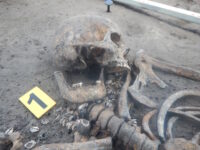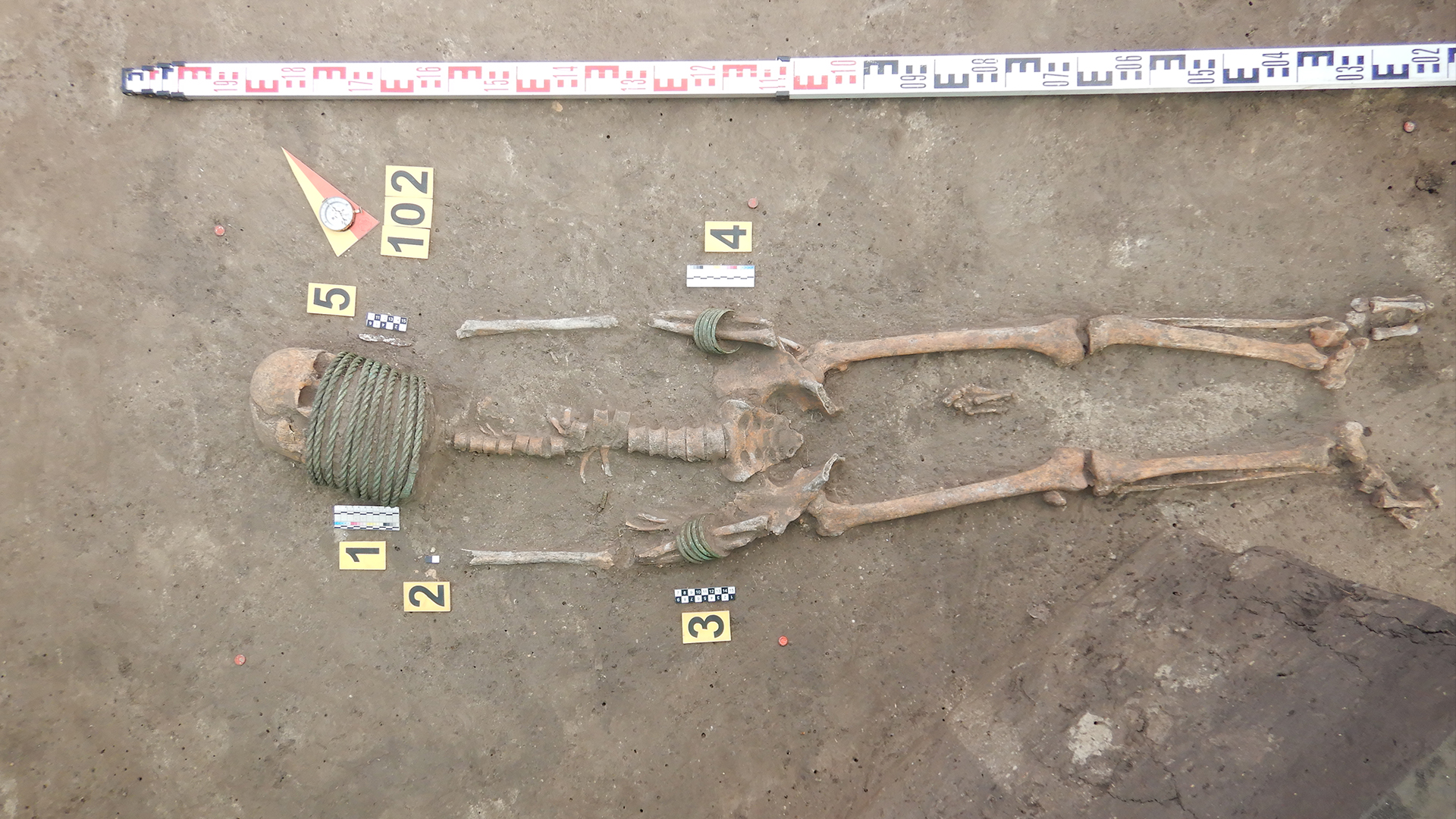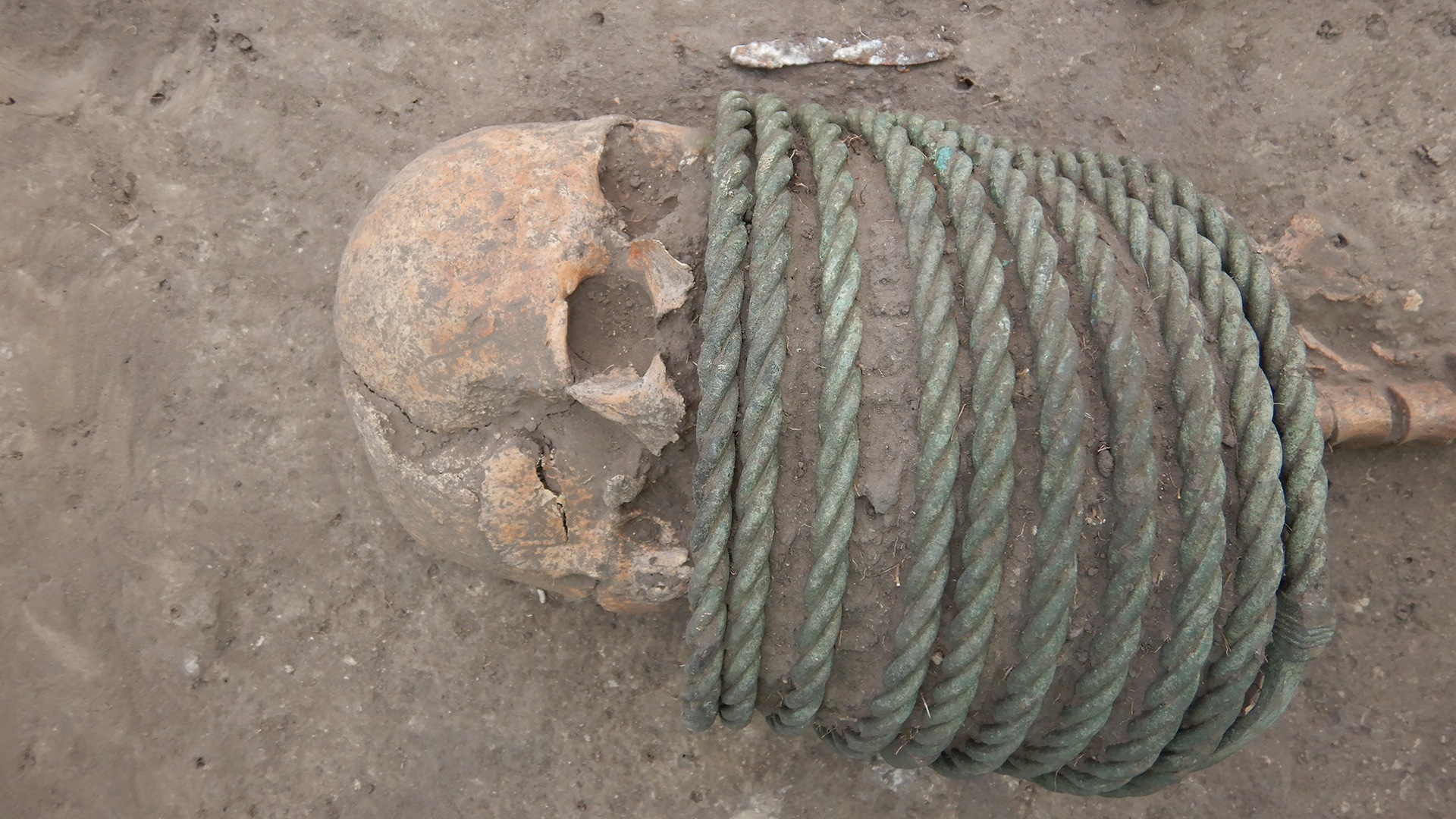The remains of women buried with thick twisted bronze neck rings have been discovered in an 11th century cemetery near the village of Ostriv south of Kyiv, Ukraine.
The 11th-century cemetery is located about 50 miles (80 kilometers) south of Kyiv. Of its 107 graves, “most of the identified burials were deposed in wooden coffins,” Vsevolod Ivakin and Vyacheslav Baranov, both archaeologists at the National Academy of Sciences of Ukraine, wrote in a paper they presented at the annual meeting of the Archaeological Institute of America, which was held Jan. 4-7 in Chicago.
The cemetery’s dead include both men and women. Some of the men were buried with weapons, such as axes, spearheads and swords, Ivakin and Baranov wrote. A few of the women were buried with elaborate neck rings, which “are found only on necks in female burials and were apparently a kind of social marker,” in this region at the time, Baranov told Live Science in an email.
An expedition by the Institute of Archaeology of Ukraine discovered the Ostriv graveyard in 2017. Between 2017 and 2022, excavations unearthed the 107 inhumation burials dating from the late 10th and 11th centuries. The unique nature of the graves was quickly apparent. Unlike the unusual funerary practices in the Kyivan Rus during this period, the graves were oriented south and west instead of north.
 The deceased were laid in supine position (on their backs), with outstretched limbs. Traces of wooden coffins were found in most of the graves. The remains of funerary food offerings (chicken bones, eggshells) were found in the graves and in wooden buckets at the feet of some of the deceased. Some individuals were laid to rest with extremely rich goods: slate spindle whorls, jewelry, including the bronze neck rings and bracelets, pennanular brooches, cast bronze belt rings, cowrie shell bead necklaces, and weapons including battles axes, knives and spearheads.
The deceased were laid in supine position (on their backs), with outstretched limbs. Traces of wooden coffins were found in most of the graves. The remains of funerary food offerings (chicken bones, eggshells) were found in the graves and in wooden buckets at the feet of some of the deceased. Some individuals were laid to rest with extremely rich goods: slate spindle whorls, jewelry, including the bronze neck rings and bracelets, pennanular brooches, cast bronze belt rings, cowrie shell bead necklaces, and weapons including battles axes, knives and spearheads.
 The orientation and funerary furnishings were very similar to the practices of Western Baltic tribes, but the comparison was not exact. Most notably, the Western Baltic peoples typically cremated their dead, and none of the Ostriv graves were cremation burials. Buckets are also not typical of Baltic funerary traditions. Archaeologists hypothesize that these key differences may be attributed to restrictions placed on traditional funerary practices by the Christian dukes of Kyiv, primarily Volodymyr the Great (r. 980-1015) and Yaroslav the Wise (r. 1019-1054), and by the process of Christianization of the Baltic settlers of the region during the 11th century. A stone altar found in the cemetery could have been used for Christian or pagan rituals, or a mixture of the two.
The orientation and funerary furnishings were very similar to the practices of Western Baltic tribes, but the comparison was not exact. Most notably, the Western Baltic peoples typically cremated their dead, and none of the Ostriv graves were cremation burials. Buckets are also not typical of Baltic funerary traditions. Archaeologists hypothesize that these key differences may be attributed to restrictions placed on traditional funerary practices by the Christian dukes of Kyiv, primarily Volodymyr the Great (r. 980-1015) and Yaroslav the Wise (r. 1019-1054), and by the process of Christianization of the Baltic settlers of the region during the 11th century. A stone altar found in the cemetery could have been used for Christian or pagan rituals, or a mixture of the two.
Excavations at Ostriv (and everywhere else in Ukraine) are on pause for now due to the Russian invasion.


That’s an *impressive* set of neck rings, I must say 😲️
I wondered if I ever saw similar ones, and actually, I have: Considerably older ones were discovered in the -Late Hallstatt- tumuli grave field of Thurnau-Berndorf near Kulmbach in Upper Frankonia, where likewise some of the women were buried with similar sets of bronze neck rings and sets of bracelets.
Hard to tell, if those rings were “Sarmatian”.
Herodotus, however, writes about the habit of taking scalps, and in Bavaria there is the 3rd century female skull from the well in the Roman Villa Rustica in Burgweinting that clearly had been scalped.
Nonetheless, to pinpoint a “culprit” is seemingly a matter of sheer speculation.
So were these rings positioned to block the view of the mouth? Was that accidental or deliberate in some way?